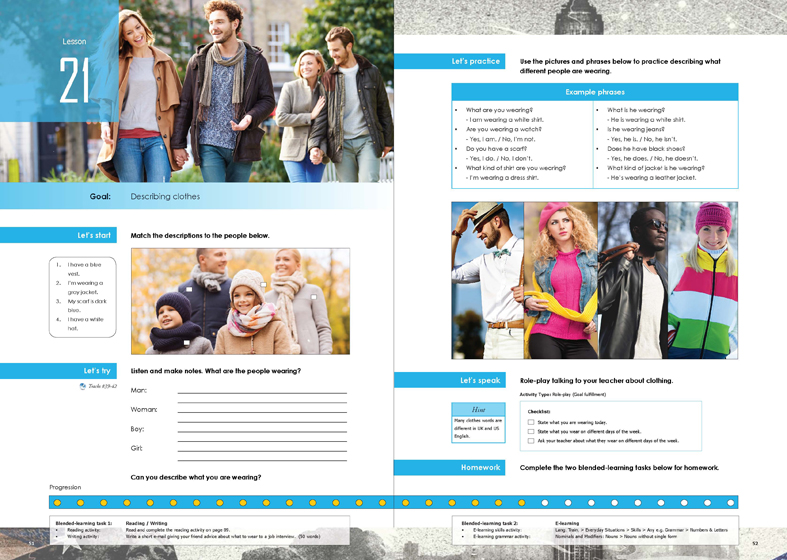
Manuals > General English > Rosetta Stone Advantage > Beginner - Book 1 > Lesson 21
< Previous Lesson | Next Lesson >

By the end of the lesson, the student should be able to describe what someone is wearing.
Communication strategies:
The student should be able to talk about clothes by following the two steps below.
- State what they are wearing today.
- State what they wear on different days of the week.
e.g. I'm wearing a black sweater, blue jeans, and black shoes. I usually wear a uniform to work during the week. On the weekend, I usually wear jeans and a T-shirt. What do you usually wear during the week?
Words and rules:
The student should be able to use the present progressive tense to describe ongoing actions.
The student should be able to name different articles of clothing.
Appropriateness:
Register: When talking to a friend about your clothes you usually use a casual register.
Social rules: We usually don't ask someone what size their clothes are.
Cultural references: The student should be knowledgeable about regional differences in regards to what different pieces of clothing are called. e.g. slacks vs trousers
Track #39
Hi, I’m James. I work in an office, so I’m wearing a grey suit, a white
shirt, and a blue tie.
Track #40
Hello, my name’s Susan. I’m going to a party tonight, so I’m
wearing a green dress and black shoes.
Track #41
Hello, I’m Jacob. Today is a school day, but I don’t have a
uniform. I’m wearing shorts and a T-shirt.
Track #42
Hi, I’m Mia. We are going to visit my grandmother today. I’m wearing
a blouse and jeans.
Because the lesson touches on the topic of describing clothes, you are welcome to introduce some of the following vocabulary if you like.
1) a dress shirt (n)
2) a flannel shirt (n)
3) a cotton shirt (n)
4) a plain shirt (n)
5) a light blue shirt (n)
6) a dark blue shirt (n)
7) a checked shirt (n)
8) a pokka dot shirt (n)
9) a polo shirt (n)
10) a striped shirt (n)
Option 1:
Difficulty ★
Type: Mind map - Vocabulary introduction
Purpose: To teach the student different clothing related words
Method: On a spare sheet of paper, create a mind map about clothing. There is an example one
in reference pics. Link below
https://drive.google.com/file/d/0B1oNohx36FidbWIwY3BQZmdVWTA/view?usp=sharing
Option 2:
Difficulty ★★
Type: Realia
Purpose: Controlled practice
Method: Google some different people before class, and have the student describe what they
are wearing.
Option 3:
Difficulty ★★★
Type: Role-play
Purpose: Fluency practice
Method: Role-play meeting someone who you haven’t met before. Have your partner describe
what they will be wearing so you can recognize them. .
Naruhodo point
English only really has one verb for “wear”, but Japanese has many different verbs for “wear”
-
かぶる (kaburu) - hat (i.e. something you wear on your head)
- 着る (kiru) - jacket, shirt, blouse, dress, suit etc. (i.e. tops and all-over clothes)
- 履く (haku) - pants, skirts, shoes (i.e. bottoms, including shoes)
- かける (kakeru) - glasses, sunglasses
- する (suru) - watch, necklace, earrings, ring, belt, necktie, makeup, etc. (i.e. accessories and makeup)
- つける (tsukeru) - perfume, cologne
Extra questions you might like to ask in the lesson
- What are you wearing?
- What has he got on?
- Who’s wearing?
- When do you usually wear…?
Let’s start
Match the descriptions to the people below.
I have a blue vest. (the man)
I’m wearing a gray jacket.( the woman)
My scarf is dark blue. (the boy)
I have a white hat. (the girl)
Let’s try
Listen and make notes. What are the people wearing?
Track #39
He’s wearing a grey suit, a white shirt, and a blue tie.
Track #40
She’s wearing a green dress and black shoes.
Track #41
He’s wearing shorts and a T-shirt.
Track #42
She’s wearing a blouse and jeans.
A) Can you describe what you are wearing?
B) I’m wearing a black suit, a white shirt and black leather shoes.
Let’s practice
Use the pictures and phrases below to practice describing what different people are wearing.
A) What’s he wearing?
B) He’s wearing a bowtie, a shirt, a brown leather belt and white pants. He also has a bag.
A) Is he wearing a watch?
B) Yes, he is.
A) Does he have a hat?
B) Yes, he does.
A) What kind of shirt is he wearing?
B) He’s wearing a dress shirt.
Let’s speak
Role-play talking to your teacher about clothing.
- State what you are wearing today.
- State what you wear on different days of the week.
- Ask your teacher about what they wear on different days of the week.
I’m wearing a black shirt and jeans at the moment. I usually wear a suit on Monday to Friday, but I wear a t-shirt and jeans on the weekend. How about you what do you usually wear?